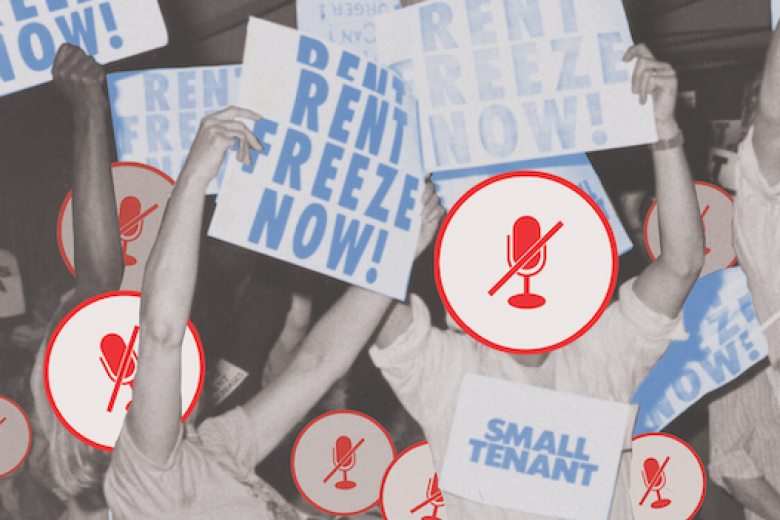Several years ago, my roommate and I were evicted from our small, ground-floor apartment in the west end of downtown Toronto. Our landlord, who lived in the apartment above us, pushed us out so that he could jack up the rent. It was two years before Vogue magazine would name the area the second hippest neighbourhood in the world, citing a “verifiable artery of indie patisseries, homegrown labels, and hidden-from-view galleries.” Even then, it was hard to imagine how much more clogged with well-heeled hipsters Toronto’s arteries could get.
Of course, we weren’t that different from them. We were in our early 30s, working salaried jobs in health care and community legal work (ironically, I was a tenant organizer). In contrast to many tenants, like those organizing rent strikes in nearby Parkdale today, we had the means to relocate within the neighbourhood and pay a slightly higher rent. Samuel Stein, the author of Capital City: Gentrification and the Real Estate State, might have described us as both “consumers” of gentrification and its victims.
Stein defines gentrification as a process where “capital is reinvested in urban neighborhoods, and poorer residents and their cultural products are displaced and replaced by richer people and their preferred aesthetics and amenities.” It’s a process that requires both producers – investors, landlords, and developers – and consumers – homeowners, tenants, shoppers, café patrons, bar hoppers. And Stein argues that it is city planners who make sure that both demand and supply exist, using state tools to spur on gentrification. It is a political process, not merely an economic or social one.
It’s refreshing to read an analysis about gentrification that avoids wallowing in moral outrage about new upscale restaurants or painting sentimental portraits of an embattled community’s “good old days.” Understanding and fighting gentrification involves answering the question of whose interests guide the state apparatus that sets the parameters of city development and how, if at all, that can be changed. Capital City focuses on the political aspect of gentrification, tracing the rise of what Stein calls the “real estate state” through the history of urban planning in the United States, relying heavily on examples from New York City.
Property interests have always held enormous power in capitalist cities, but Stein argues that it is various capitalists’ specific needs that can explain the gentrification remaking North American cities today. When manufacturing is a major urban industry, it’s not only renters who want lower land costs; industries want cheap land for their factories and housing that’s affordable for the low-wage workforce that keeps their assembly lines moving. The neoliberal turn in the 1980s and 1990s resulted in the flight of manufacturing to rural areas and free-trade zones in countries in the Global South. Real estate went from being “a secondary to a primary source of urban capital accumulation” argues Stein, and planners helped to pave the way.
Beholden to the newly ascendant power bloc of developers, landlords, and building trades, and reliant on property taxes to fund city services, municipalities rallied their planners to enact measures to spur rising property values. Planners have a variety of tools to do so: cuts to property taxes and zoning changes to incentivize investment in specific areas of the city; “revitalizing” social housing by demolishing whole projects that had fallen into disrepair as a result of severe underfunding; selling off tax-foreclosed properties. (Stein cites a 1983 study that found more than a third of Harlem’s housing had been possessed by the city, most of the buildings sold on the cheap to landlords.)
Beholden to the newly ascendant power bloc of developers, landlords, and building trades, and reliant on property taxes to fund city services, municipalities rallied their planners to enact measures to spur rising property values.
Stein, who ultimately believes in the radical possibilities of urban planning, notes that even progressive or radical planners are stuck with a terrible contradiction under a real estate monopoly. If they enact policies to improve an area by adding parks, transit, or better amenities, or try to recapture some of the value created by zoning changes (inclusionary housing policies that demand a certain percentage of new developments be affordable, for example) the end result is the same: a rise in property values. Absent strict rent controls and other tenure protections, displacement of lower-income residents is the almost-certain result.
Capital City expends considerable pages showing the reader how this has played out under both neoliberal and “progressive” mayoral regimes (New York’s Michael Bloomberg and Bill de Blasio, respectively). Stein also devotes a chapter to a history of the Trump family and the New York-born “developer president.” These narratives are compelling but inadvertently point to a potential weakness with the book: its focus on a city so unlike many others in North America.
Stein argues that under a real estate (city-)state, housing struggles, like labour struggles in industrial towns, become a “crucial conduit for labor action.” Tenants could form an “unbeatable bloc,” he says, pointing to New York, where 68 per cent of residents are renters. But what about everywhere else? The closest we come to that in Canada is in Montreal, with 44 per cent renters. All of our cities are majority homeowners. And as a country, Canada has a home ownership rate of almost 68 per cent. If it’s purely a numbers game (which strategy proposals like Stein’s – predicated on rent strikes to create crisis moments for the landlord class – essentially are) then we might be in trouble.
“Landlords and tenants do not want the same urban planning,” writes Stein, “just like bosses and workers do not want the same salary structures.” That may be true, but for those of us who live outside New York City, any radical housing movement will have to address those whom Stein neglects to mention: homeowners who aren’t landlords. We’ll need to move at least some of them from opponents to allies.
Enlisting homeowners in a movement to lower property values, reform the tax system to prevent speculation and regulate investment in real estate won’t be an easy sell, but it’s not totally impossible. It will, however, require winning at least one demand not considered by Stein: defending and improving the social safety net. Homeowners are relying on increased house values to fund their retirement and leave something for their families after they die. As long as property offers a secure investment with a better rate of return than most anything else, people will buy houses, planners will craft policies to protect and raise the land value, and people with less will be displaced by those with more.







